“In July, when most of the insects in my sunny country are parched with thirst, the Cicada remains perfectly cheerful”
Fabre’s Book of Insects
A cicada is an insect of the order Hemiptera, suborder Homoptera and family Cicadidae. Leafhoppers, spittle bugs and jumping plant lice are close relatives of the cicada. Hemiptera are different from other insects in that both the nymph and adult forms have a beak, which they use to suck fluids called xylem from plants. This is how they both eat and drink.
The name is a direct derivation of the Latin cicada, meaning “tree cricket”. There is no word of proper English etymology for the insect. Cicadas live in temperate to tropical climates (the average temperature of the natural habitat for this species is approximately 29 °C (84 °F) ), where they are among the most widely recognized of all insects, mainly due to their large size and unique sound.
DESCRIPTION
The adult of the species Cicada Orni reach approximately 25 millimetres (0.98 in) of length, and have a wingspan of about 70 millimetres (2.8 in).
The cryptic coloration of the body varies from brown to gray. The abdomen has reddish segments and a silky pubescence. The head show large and prominent eyes wide apart on the sides, three small eyes (ocelli) located on the top, very short antennae and a long proboscis used for feeding on sap. The membranous front wings are transparent, with well drawn veins and several characteristic black spots.
Life cycle of a typical Cicada
Adult cicadas, also called imagoes spend their time in trees looking for a mate. Males sing, females respond, mating begins, and the cycle of life begins. Following mating, the female cuts grooves into the bark of a twig or small branch, and into these she deposits her eggs. She may do so repeatedly, until she has laid several hundred eggs.These grooves can kill small branches but provide shelter and expose the tree fluids which the newly emerged cicada larvae begin to feed on.At this stage the tiny larvae resemble a termite or small white ant.
Once the young cicada is ready, it crawls from within the groove and falls to the ground where it will burrow until it finds a root to feed on. Once a root is found the cicada will stay underground for 2 – 17 years depending on the species. In the final nymphal instar, they construct an exit tunnel to the surface and emerge from the ground as nymphs; they climb a nearby tree or plant, and begin to shed their nymph exoskeleton. The abandoned skins remain, still clinging to the tree.Once emerged the veins in the wings are inflated with fluid and the new skin can harden. Once their new wings and body are ready, they can begin their brief adult life.
DIET
Cicada nymphs suck xylem from the roots of various species of tree, including oak, cypress, ash and maple. While it is common folklore that adults do not eat, in reality they do have a long proboscis under their head that they use for feeding on tree sap.
HOW THE SOUND IS PRODUCED
Cicadas are best known for the sound they produce. Their “singing” is not produced in the same way as that of many other familiar sound-producing insects like crickets, where one structure is rubbed against another. Rather, the males make this sound by flexing their tymbals, which are drum-like organs found on their abdomens. Female cicadas also make a sound by flicking their wings, but it isn’t the same as the song cicadas are known for. All species have their own distinctive “song” to ensure they attract the appropriate mate..
Some cicadas produce sounds of up to 120 decibels, among the loudest of all insect-produced sounds. This is especially notable as their song is technically loud enough to cause permanent hearing in humans, should the cicada sing just outside the listener’s ear (highly unlikely). Conversely, some small species have songs so high in pitch that the noise is inaudible to humans.
Despite its volume it can be difficult to determine from which direction(s) cicada song is coming, this is because the low pitch carries well and because it may, in fact, be coming from many directions at once, as cicadas in various trees all raise one another to make noise in unison. Although relatively loud, cicada song can be comforting and even hypnotic at times, as it is at its loudest during the hottest time of an already hot day.
PREDATION
Cicadas are commonly eaten by birds, but Massospora cicadina (a fungal disease) is the biggest enemy of cicadas.
CICADAS & PEOPLE
Cicadas are benign to humans in normal circumstances and do not bite or sting in a true sense, but may in fact bite after mistaking a person’s arm or other part of their body as a tree or plant limb and attempt to feed, and if they attempt to inject it into a person’s body it can be painful, but is in no other way harmful. This sting is not a defensive reaction and should not be mistaken for aggression; it is extremely uncommon, and usually only happens when they are allowed to rest on a person’s body for an extended amount of time.
Cicadas can cause damage to several cultivated crops, shrubs, and trees, mainly in the form of scarring left on tree branches while the females lay their eggs deep in branches. Many people around the world regularly eat cicadas though the female is prized for being meatier. Cicadas have also been known to be eaten in Ancient Greece, China, Malaysia, Burma, Latin America and the Congo. Shells of cicadas are employed in the traditional medicines of China.
FOLKLORE, FABLE & FABRE
In France, the cicada is used to represent the folklore of Provence and Mediterranean cities. In the Ancient Greek myth, Tithonus eventually turns into a cicada after being granted immortality, but not eternal youth, by Zeus.
The cicada has represented insouciance (i.e. nonchalance or indifference) since classical antiquity. Jean de La Fontaine began his collection of fables Les fables de La Fontaine with the story La Cigale et la Fourmi (The Cicada and the Ant) based on one of Aesop’s fables: in it the cicada spends the summer singing while the ant stores away food, and finds herself without food when the weather turns bitter. However, this fable is discredited by Fabre who declares the fable to be ‘a slander’.
“The Cicada is no beggar…..there are sometimes dealings between the Cicada and the Ant, but they are the exact opposite of those described in the fable….On the contrary it is the Ant who, driven by hunger, begs and entreats the singer. Entreats, did I say? It is not the right word. She brazenly robs him”. He goes on to describe how the Cicada bores into the tree bark with his rostrum, which is “sharp as a gimlet” and that once sap begins to ooze from his well all manner of other insects son arrive to quench their thirst. At first, according to Fabre’s observations, their behaviour is quiet and discreet, but the larger insects soon become ‘violent brigands, determined to chase the Cicada away from his well. The worst offenders are the Ants. I have seen them nibbling at the ends of the Cicada’s legs, tugging at the tips of his wings, and climbing on his back…..At last, worried beyond all patience, the singer deserts the well he has made….So you see that the actual facts are just the reverse of those in the fable. The Ant is the hardened beggar: the industrious worker is the Cicada”.




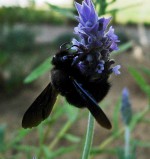
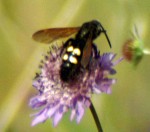
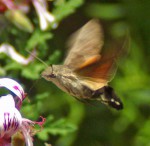

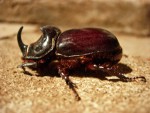
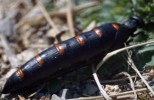
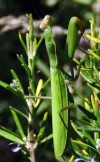

Excellent description of the Cicadas the only piece of info missing is the discernible ‘chirp’ they always make when they are threatened or chased away. No other insect does this!
We live in Southern Spain and often see ‘unusual’ insects, recently a very small fly with a perfect ‘spider’ image on each wing and yesterday a small thin fly or wasp with a black triangular protrusion under its chin ( managed to photograph the latter)
A nightingale sang through the night in the garden of our house last night ….. how special!
Kind regards ….Mike Hennell
LikeLike
Thank you for your comments and for the added info – I didn’t know that. I loved living in Southern Spain and I do miss ‘my’ Nightingales! I am fortunate to still have friends there I can visit for ‘top-ups’ though. The diversity of flora and fauna is quite mind-boggling! If you ever feel the need to commune with like-minded folk, I thoroughly recommend joining the Gibraltar Ornithological and Natural History Society who run the bird observatory, have experts on flora & fauna & arrange outings, some in Gib others in Spain: http://www.gonhs.org/ Best wishes, Theresa
LikeLike